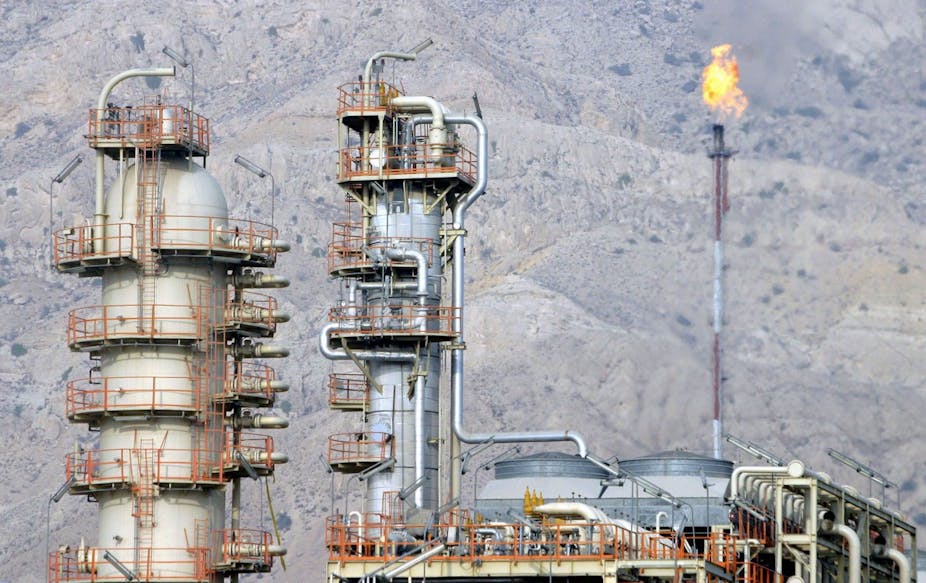The problem of climate change policy at an international level is not only about reaching agreement on sharing the mitigation burden. It is also about how dysfunctional foreign policies - not directly related to climate change policy - can pose major obstacles to meeting global emissions targets.
The relationship between the United States and Iran is one such situation. A proposed gas pipeline from Iran to Pakistan is on hold, due to US sanctions on Iran which make it difficult to fund the pipeline. The LA Times reported:
Secretary of State Hillary Rodham Clinton has warned that there would be ‘damaging consequences’ if Pakistan continued with the pipeline because U.S. sanctions bar American financial institutions and companies from doing business with any concerns that have ties to Iran.
US economic warfare on Iran is nothing new. But it does more than exacerbate Middle East instability: missing from Clinton’s characteristically bellicose statement is the fact that such economic warfare also significantly retards attempts to mitigate climate change.
Despite the fact that natural gas is a fossil fuel, its role in cost-effectively reducing global CO₂ emissions is potentially vital in many important circumstances.
The potential for China and India to shift away from coal through the use of Iranian gas is one such case.
Iranian gas: reserves-rich but export poor
As indicated by BP data, Iran is a country that possesses the world’s second largest reserves of natural gas, yet its exports are minimal.


Sanctions on Iran not only restrict the ability of Iran to export gas, but also increase the market power of Iran’s potential rival gas exporters, Russia, Qatar and Turkmenistan. This raises the price of gas, making it less competitive for importers relative to coal.
The threat from China’s coal-dependence
The greatest area of concern is China’s escalating CO₂ emissions from coal-fired power stations. India’s situation is very similar.
China lacks conventional gas resources, and access to non-conventional gas is severely constrained by technological and environmental uncertainty associated with fracking.
This leaves China hugely dependent on coal-fired electricity generation - even more so than the US.

The radical reduction in coal-fired capacity forecast for 2035 in the above figure is required under the IEA’s 450 ppm scenario. This scenario implies an upper limit of 2°C increase in mean global temperatures since the industrial revolution, and is accepted as a necessary upper limit to reduce the risk of globally catastrophic consequences.
The Chinese leadership is apparently prepared to act on climate change, but is constrained by China’s coal dependence problem. It cannot rely solely on its laudable efforts in regard to renewables.
If China is to meet its share of the global emissions reduction target, radical policy action is required on several fronts. Pricing China’s emissions is urgent and indispensable, but so is unimpeded international access to low emission energy sources and technologies.

Electricity from gas can complement renewables
Where there is a reasonable price on CO₂, gas provides a cost-effective substitute for new coal-fired generating capacity, and a somewhat higher rate will back out older coal-fired capacity. Combined cycle gas turbines’ (CCGT) emissions per kWh are only half those of coal-fired generation.
Gas is an ideal “bridging fuel” in a long-term shift toward emissions-free electricity generation. CCGT has very short start-up times, making it complementary to more intermittent renewables.
It is also cost-effectively modular. Plants can be built quickly, which makes it easier to match gas powered electricity generation to emerging but not fully predictable demand trends. This helps to avoid the extremes of both under-capacity (compromising system reliability) and over-capacity (compromising end-use energy savings) in electricity generation.
But for CCGT to be an effective bridging fuel, supplies of gas must be secure, reliable and diverse.
The politics of international CCGT pipelines
It is easier for both importers and exporters of gas to reach the goals of cost-effectiveness, energy security and revenue security if gas is available on the same land mass, and if multiple pipeline and LNG facility options are available.
All parties to such trade, including transit states crossed by gas pipelines, have an interest in precluding terrorist threats to pipelines and associated facilities. They have enough incentive to prevent terrorism; US presence is not required in this regard.

Transcontinental oil and gas pipelines and pipeline proposals can also have geostrategic significance and obstacles. There are 15 such pipelines worldwide, 12 of which are for gas.
These include a pipeline connecting gas-rich Turkmenistan to China, as well as two proposals that supposedly rival one another: one connecting Iran to India–Pakistan (IPI) and one connecting Turkmenistan to India–Pakistan (TAPI).
The US has staunchly opposed the former because of the involvement of Iran, and has quietly supported the latter. Facilitating the TAPI option is viewed by some as a major US strategic aim in the Afghanistan war.
At least one staunch US advocate of TAPI (and opponent of IPI) has acknowledged the greenhouse benefits of IPI but opposed it on the usual grounds of maintaining Iran’s isolation.
A realised US aim has been to scuttle India as an import market for gas, especially Iranian gas. The US’s preferred alternative implemented under the George W Bush Administration was to enter into a nuclear power deal with India.
This was despite the fact that India, like Israel and Pakistan, is not a participant in the NNPT. In obvious contrast, Iran is a NNPT participant.
The potential for a win-win situation
The question is not whether Middle East security must be “traded off” against the goal of radically reducing global greenhouse gas emissions.
Rather, it rests on the prior argument (and in extended form here) that removing economic sanctions preventing Iranian gas exports has the potential to contribute to both of these objectives.
As Stephen Kinzer has pointed out, ending Iran’s international isolation through constructive engagement has many potential benefits; on page 208 of his 2011 book he lists ten. The potential to reduce greenhouse gas emissions through the export of Iranian gas is among the most significant of these.

